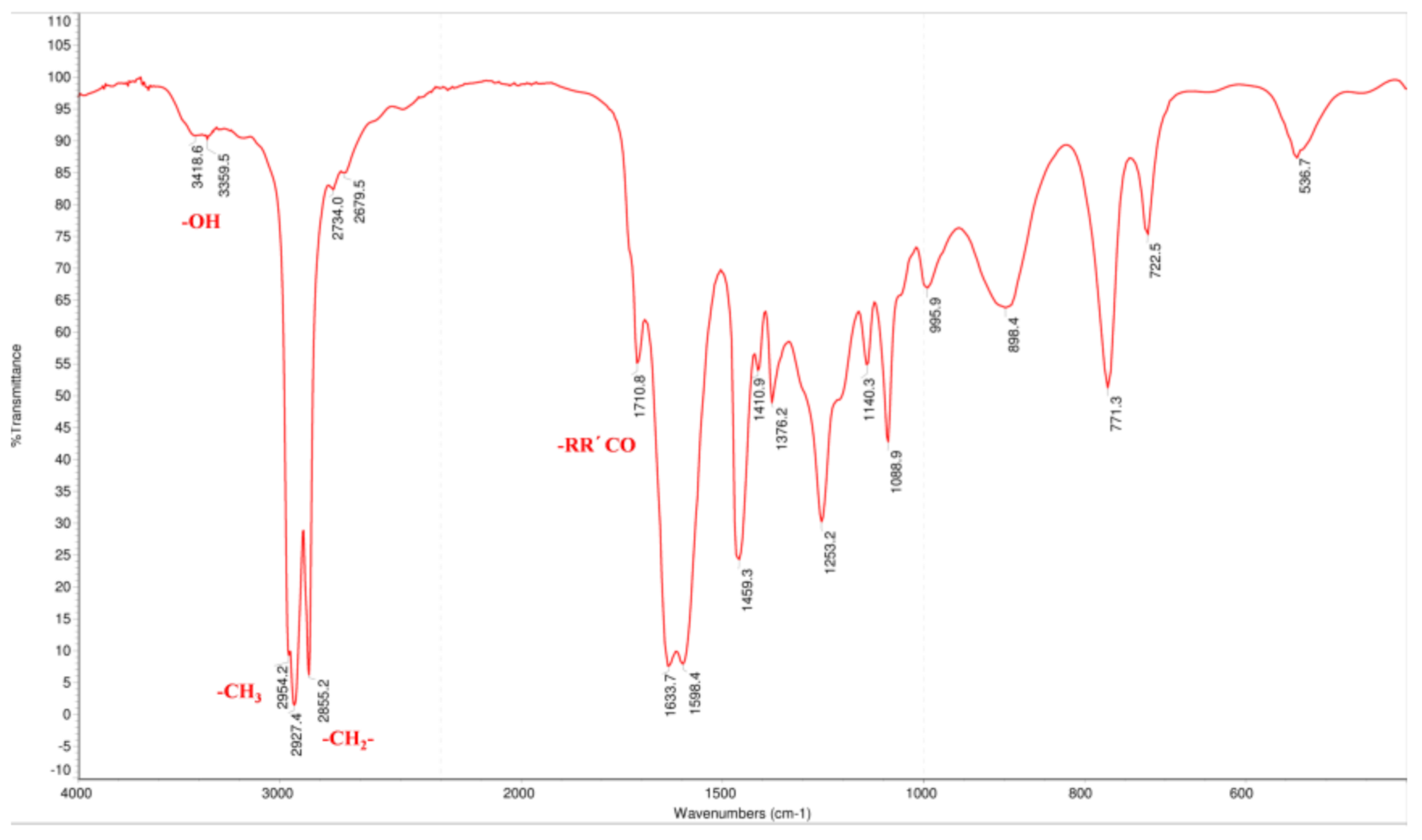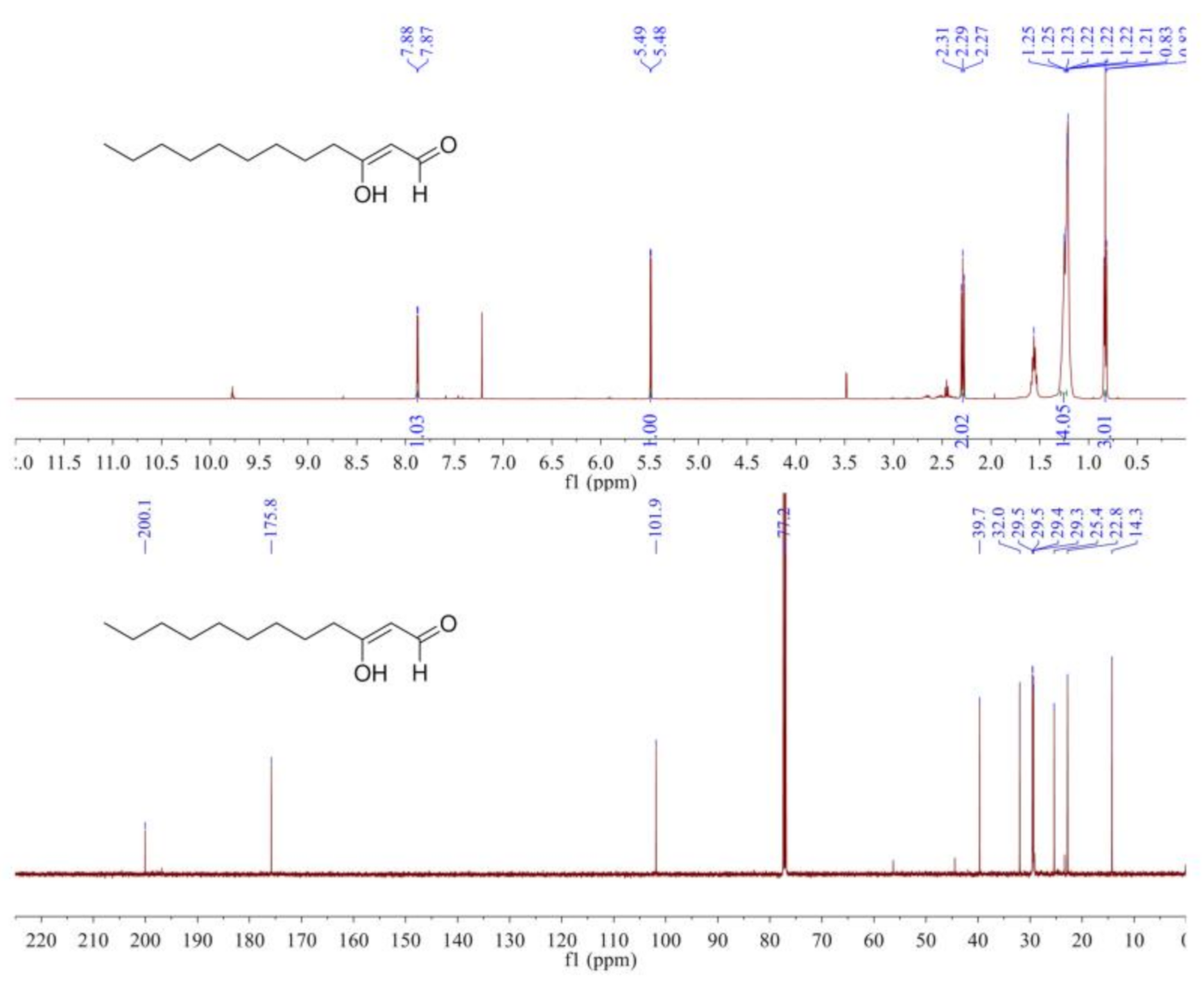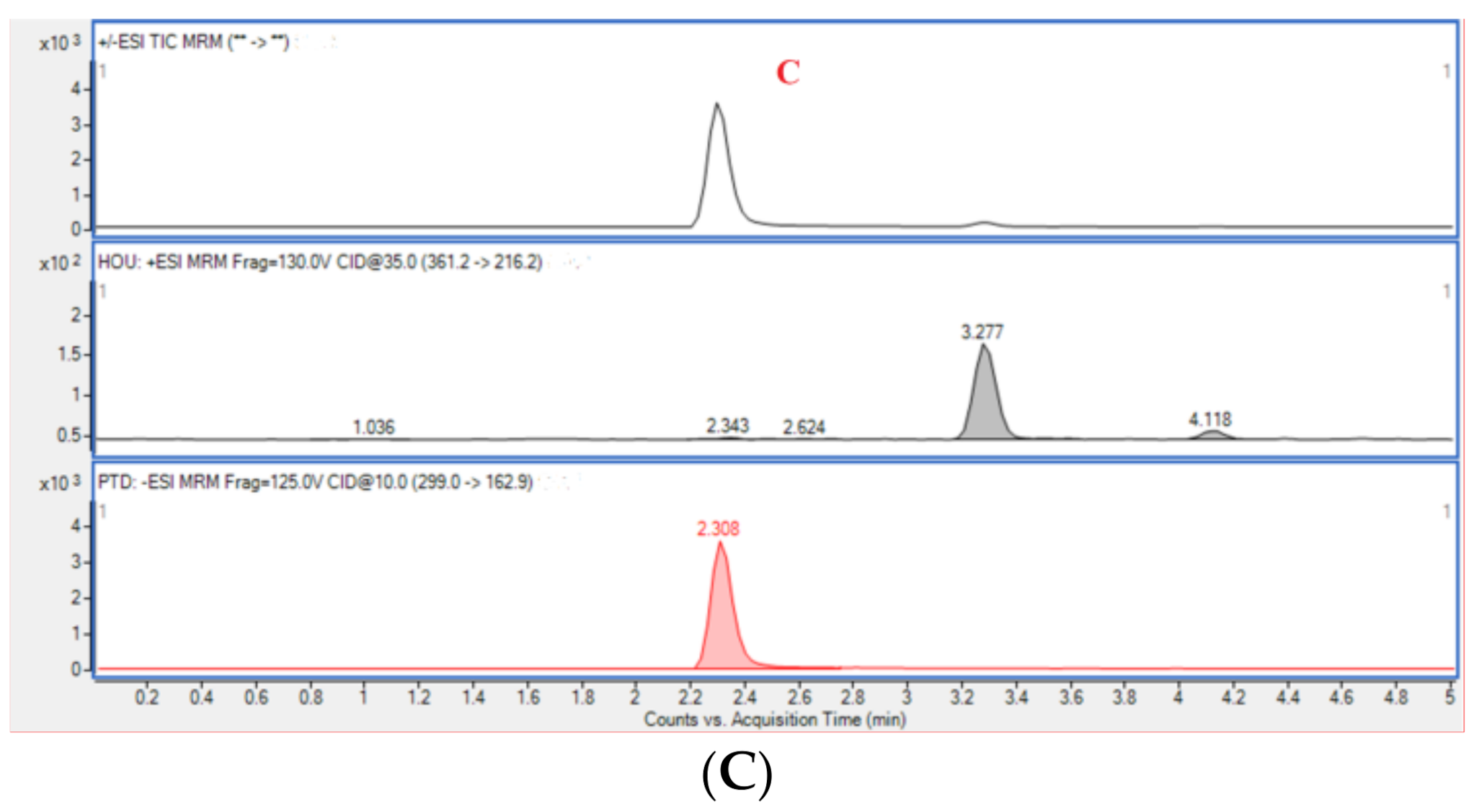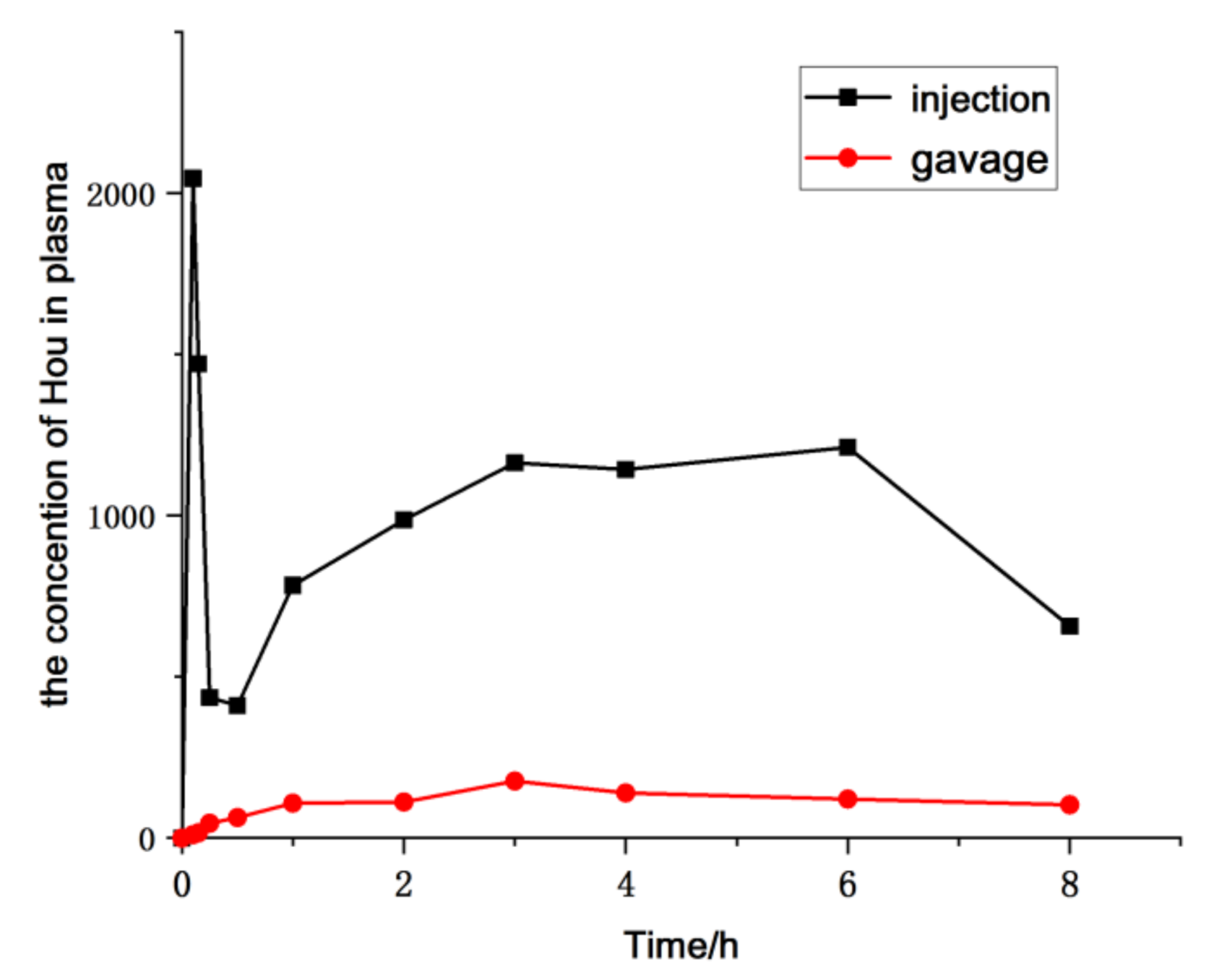Development and Verification of a Precolumn Derivatization LC-MS/MS Method for the Pharmacokinetic Study of Houttuynine of Houttuynia Essential Oil
Abstract
1. Introduction
2. Results
2.1. Method Development
2.2. Method Validation
2.2.1. Selectivity
2.2.2. Calibration Curve and Lower Limit of Quantification (LLOQ)
2.2.3. Accuracy and Precision
2.2.4. Matrix Effects and Recovery
2.2.5. Stability
2.3. Pharmacokinetic Study
2.4. Safety Evaluation
3. Materials and Methods
3.1. Materials
3.2. Preparation of the Hou Standard
3.3. Preparation of HEO
3.4. LC-MS/MS Instrumentation and Conditions
3.5. Preparation of Stock Solutions and Calibration Standards
3.6. Plasma Sample Pretreatment
3.7. Method Validation
3.7.1. Selectivity
3.7.2. Calibration Curve
3.7.3. Precision and Accuracy
3.7.4. Matrix Effect and Extraction Recovery
3.7.5. Stability
3.8. Pharmacokinetic Study
3.8.1. Animal Study
3.8.2. Plasma Sample Preparation
3.8.3. Safety Evaluation
3.8.4. Data Analysis
4. Conclusions
Author Contributions
Funding
Institutional Review Board Statement
Informed Consent Statement
Data Availability Statement
Acknowledgments
Conflicts of Interest
Sample Availability
References
- Kumar, M.; Prasad, S.K.; Hemalatha, S. A current update on the phytopharmacological aspects of Houttuynia cordata Thunb. Pharmacogn. Rev. 2014, 8, 22–35. [Google Scholar] [CrossRef]
- Shingnaisui, K.; Dey, T.; Manna, P.; Kalita, J. Therapeutic potentials of Houttuynia cordata Thunb. against inflammation and oxidative stress: A review. J. Ethnopharmacol. 2018, 220, 35–43. [Google Scholar] [CrossRef] [PubMed]
- Fu, J.G.; Dai, L.; Lin, Z.; Lu, H.M. Houttuynia cordata Thunb: A review of phytochemistry and pharmacology and quality control. Chin. Med. 2013, 4, 101–123. [Google Scholar]
- Cheng, D.Q.; Sun, L.; Zou, S.Y.; Chen, J.; Mao, H.Y.; Zhang, Y.J.; Liao, N.B.; Zhang, R.H. Antiviral Effects of Houttuynia cordata polysaccharide extract on murine norovirus-1 (MNV-1)—A human norovirus surrogate. Molecules 2019, 24, 1835. [Google Scholar] [CrossRef] [PubMed]
- Her, Y.; Lee, T.K.; Ahn, J.H.; Lim, S.S.; Kang, B.G.; Park, J.S.; Kim, B.; Sim, H.; Lee, J.-C.; Kim, H.S.; et al. Chemical composition of a novel distillate from fermented mixture of nine anti-inflammatory herbs and its UVB-protective efficacy in mouse dorsal skin via attenuating collagen disruption and inflammation. Molecules 2021, 26, 124. [Google Scholar] [CrossRef]
- Lau, K.M.; Lee, K.M.; Koon, C.M.; Cheung, S.F.; Lau, C.P.; Ho, H.-M.; Lee, M.Y.-H.; Au, S.W.-N.; Cheng, C.-H.K.; Lau, C.B.-S.; et al. Immunomodulatory and anti-SARS activities of Houttuynia cordata. J. Ethnopharmacol. 2008, 118, 79–85. [Google Scholar] [CrossRef] [PubMed]
- Subhawa, S.; Chewonarin, T.; Banjerdpongchai, R. The Effects of Houttuynia cordata Thunb and Piper ribesioides Wall Extracts on Breast Carcinoma Cell Proliferation, Migration, Invasion and Apoptosis. Molecules 2020, 25, 1196. [Google Scholar] [CrossRef]
- Nuengchamnong, N.; Krittasilp, K.; Ingkaninan, K. Rapid screening and identification of antioxidants in aqueous extracts of Houttuynia cordata using LC-ESI-MS coupled with DPPH assay. Food Chem. 2009, 117, 750–756. [Google Scholar] [CrossRef]
- Rebickova, K.; Bajer, T.; Silha, D. Chemical composition and determination of the antibacterial activity of essential oils in liquid and vapor phases extracted from two different southeast Asian herbs—Houttuynia cordata (saururaceae) and persicaria odorata (polygonaceae). Molecules 2020, 25, 2432. [Google Scholar] [CrossRef]
- Yang, L.; Jiang, J.G. Bioactive components and functional properties of Hottuynia cordata and its applications. Pharm. Biol. 2009, 47, 1154–1161. [Google Scholar] [CrossRef]
- Xu, Q.S. Research status of volatile oil from Houttuynia cordata Thunb. Pharm. Ind. China 2014, 4, 15–18. [Google Scholar]
- Zeng, H.Y.; Jiang, L.J.; Zhang, Y.C. Chemical constituents of volatile oil from Houttuynia cordata Thunb. J. Plant Resour. Environ. 2003, 12, 50–52. [Google Scholar]
- Yang, L.S.; Ji, W.W.; Zhong, H.; Wang, L.Y.; Zhu, X.L.; Zhu, J. Anti-tumor effect of volatile oil from Houttuynia cordata Thunb. on HepG2 cells and HepG2 tumor bearing mice. RSC Adv. 2019, 9, 31517–31526. [Google Scholar] [CrossRef]
- Li, W.F.; Fan, T.; Zhang, Y.M.; Fan, T.; Zhou, P.; Niu, X.F.; He, L.C. Houttuynia cordata Thunb. volatile oil exhibited anti-inflammatory effects in vivo and inhibited nitric oxide and tumor necrosis factor-α production in LPS-stimulated mouse peritoneal macrophages in vitro. Phytother. Res. 2013, 27, 1629–1639. [Google Scholar] [CrossRef] [PubMed]
- Chen, J.; Wang, W.; Shi, C.; Fang, J. A comparative study of sodium houttuyfonate and 2-undecanone for their in vitro and in vivo anti-inflammatory activities and stabilities. Int. J. Mol. Sci. 2014, 15, 22978–22994. [Google Scholar] [CrossRef]
- Oh, S.Y. An effective quality control of pharmacologically active volatiles of Houttuynia cordata Thunb by fast gas chromatography-surface acoustic wave sensor. Molecules 2015, 20, 10298–10312. [Google Scholar] [CrossRef] [PubMed]
- Wang, B.Y.; Yang, Y.F.; Pang, J.M.; Liu, Z.H.; Jiang, L.M.; Liu, Y.L. Simultaneous quantification of nine volatile oils in Houttuynia cordata extracts by GC. China Pharm. 2019, 22, 1261–1264. [Google Scholar]
- Duan, X.T.; Zhong, D.F.; Chen, X.Y. Derivatization of β-dicarbonyl compound with 2,4-dinitrophenylhydrazine to enhance mass spectrometric detection: Application in quantitative analysis of houttuynin in human plasma. J. Mass Spectrom. 2008, 43, 814–824. [Google Scholar]
- Yang, N.; Li, Y.J.; Zhou, B.S.; Li, Y.M.; Zhao, W.J.; Liu, J.P.; Li, P.Y. Analysis of chemical compounds of essential oils of Astragalus by SPME-GC-MS. CJTCMP 2018, 33, 3627–3630. [Google Scholar]
- Jang, Y.R.; Cho, K.; Kim, S.W.; Altenbach, S.B.; Lim, S.H.; Sim, J.R.; Lee, J.Y. Development of an optimized MALDI-TOF-MS method for high-throughput identification of high-molecular-weight glutenin subunits in wheat. Molecules 2020, 25, 4347–4365. [Google Scholar]
- Zhu, H.L.; Mao, X.B.; Li, L.Y.; Liu, H. Analysis of aristolochie acid a content in asarum volatile oil. J. Southwest China Norm. Univ. Nat. Sci. Ed. 2015, 40, 177–180. [Google Scholar]
- Xie, J.; He, J.M. GC-MS The application of gas chromatography-mass spectrometry (GC-MS) in the detection and analysis of volatile oil in plants. J. Shaoguan Univ. Nat. Sci. 2020, 41, 61–65. [Google Scholar]
- Xu, R.; Jiang, L.M.; He, J.M.; Liu, Y.L. The condensation mechanism of sodium new houttuyfonate and determination of the chemical structure of condensation products. Acta Pharm. Sin. 2009, 44, 609–614. [Google Scholar]
- Xue, Q.S.; Wang, Z.; Yin, R.H. Highly efficient extraction of decanoyl acetaldehyde in Houttuynia cordata Thunb. under steam distillation and its mass spectrometric analysis. J. Anal. Sci. 2012, 28, 28–33. [Google Scholar]
- Yi, Y.; Liang, A.H.; Liu, T.; Li, C.Y.; Zhao, Y.; Cao, C.Y. Analysis of causes for adverse reaction of houttuynia injection. China J. Chin. Mater. Med. 2008, 33, 2439–2442. [Google Scholar]
- Xue, Q.S.; Yin, H.R. Highly efficient extraction of decanoyl acetaldehyde in Houttuynia cordata Thunb under solvent immersin. J. Anal. Sci. 2013, 29, 386–390. [Google Scholar]
- Pang, J.M.; Dong, W.J.; Li, Y.H.; Xia, X.J.; Liu, Z.H.; Hao, H.Z.; Jiang, L.M.; Liu, Y.L. Purification of Houttuynia cordata Thunb. essential oil using macroporous resin followed by microemulsion encapsulation to improve its safety and antiviral activity. Molecules 2017, 22, 293–309. [Google Scholar]
- Zwiener, C.; Glauner, T.; Frimmel, F. Method optimization for the determination of carbonyl compounds in disinfected water by DNPH derivatization and LC–ESI–MS–MS. Anal. Bioanal. Chem. 2002, 372, 615–621. [Google Scholar] [CrossRef]
- Chi, Y.G.; Feng, Y.L.; Wen, S.; Lv, H.X. Determination of carbonyl compounds in the atmosphere by DNPH derivatization and LC–ESI-MS/MS detection. Talanta 2007, 72, 539–545. [Google Scholar] [CrossRef]
- Richardson, S.D.; Caughran, T.V.; Poiger, T.; Guo, Y.B.; Crumley, F. Application of DNPH derivatization with LC/MS to the identification of polar carbonyl disinfection byproducts in drinking water. J. Int. Ozone Assoc. 2000, 22, 653–675. [Google Scholar] [CrossRef]
- US Food and Drug Administration. Guidance for Industry: Bioanalytical Method Validation; US Food and Drug Administration: Washington, DC, USA, 2001. [Google Scholar]








| Catalyst | Concentration (%) | Response Values * of the IS | Response Values * of Hou-Derivatives |
|---|---|---|---|
| HCl | 20 | 9628 | 235,556 |
| HCl | 10 | 12,158 | 244,090 |
| HCl | 5 | 14,738 | 243,659 |
| FA | 20 | 49,170 | 52,187 |
| FA | 10 | 59,359 | 22,483 |
| FA | 5 | 61,493 | 9440 |
| Catalyst | Concentration (%) | Response Values * of the IS | Response Values * of Hou-Derivatives |
|---|---|---|---|
| HCl | 5 | 7867 | 379,525 |
| HCl | 5 | 11,956 | 348,219 |
| HCl | 2 | 10,764 | 423,701 |
| HCl | 2 | 10,146 | 419,683 |
| HCl | 1 | 15,631 | 23,714 |
| HCl | 1 | 20,048 | 52,315 |
| Analyte | Concentration (ng/mL) | Intraday Stability | ||
|---|---|---|---|---|
| Measurement (ng/mL) | Accuracy (%) | RSD (%) | ||
| Hou-Derivatives | 10 | 11.56 ± 1.32 | 115.6 | 11.42 |
| 50 | 38.84 ± 2.04 | 77.7 | 5.25 | |
| 200 | 189.33 ± 21.02 | 94.7 | 11.10 | |
| Analyte | Concentration (ng/mL) | Intraday Stability | ||
|---|---|---|---|---|
| Measurement (ng/mL) | Accuracy (%) | RSD (%) | ||
| Hou-Derivatives | 10 | 8.98 ± 0.71 | 89.8 | 7.85 |
| 50 | 45.87 ± 1.46 | 91.7 | 3.18 | |
| 200 | 172.16 ± 10.19 | 86.1 | 5.92 | |
| Parameter | Unit | Injection | Gavage |
|---|---|---|---|
| T1/2 | h | 5.987 ± 0.52 | 6.45 ± 0.94 |
| Tmax | h | 0.033 ± 0.012 | 3.71 ± 1.07 |
| Cmax | μg/L | 2010 ± 350 | 222.48 ± 20.38 |
| AUC(0–t) | μg/L × h | 32,693.2 ± 1320 | 2451.79 ± 300.01 |
| AUC(0–∞) | μg/L × h | 34,630.466 ± 1436 | 2451.837 ± 432.74 |
| MRT(0–t) | h | 7.575 ± 1.21 | 8.914 ± 2.73 |
| MRT(0–t) | h | 9.153 ± 0.98 | 11.594 ± 1.85 |
| Vz | L/kg | 5.611 ± 0.97 | 85.81 ± 5.74 |
| CLz | L/h·kg | 0.638 ± 0.086 | 8.856 ± 3.68 |
| F | % | 100 | 7.08 |
Publisher’s Note: MDPI stays neutral with regard to jurisdictional claims in published maps and institutional affiliations. |
© 2021 by the authors. Licensee MDPI, Basel, Switzerland. This article is an open access article distributed under the terms and conditions of the Creative Commons Attribution (CC BY) license (https://creativecommons.org/licenses/by/4.0/).
Share and Cite
Liu, Y.; Yang, Y.; Wang, B.; Wang, R.; Pang, J.; Jiang, Y.; Liu, Y. Development and Verification of a Precolumn Derivatization LC-MS/MS Method for the Pharmacokinetic Study of Houttuynine of Houttuynia Essential Oil. Molecules 2021, 26, 2327. https://doi.org/10.3390/molecules26082327
Liu Y, Yang Y, Wang B, Wang R, Pang J, Jiang Y, Liu Y. Development and Verification of a Precolumn Derivatization LC-MS/MS Method for the Pharmacokinetic Study of Houttuynine of Houttuynia Essential Oil. Molecules. 2021; 26(8):2327. https://doi.org/10.3390/molecules26082327
Chicago/Turabian StyleLiu, Yuanyuan, Yanfang Yang, Bangyuan Wang, Renyun Wang, Jianmei Pang, Yu Jiang, and Yuling Liu. 2021. "Development and Verification of a Precolumn Derivatization LC-MS/MS Method for the Pharmacokinetic Study of Houttuynine of Houttuynia Essential Oil" Molecules 26, no. 8: 2327. https://doi.org/10.3390/molecules26082327
APA StyleLiu, Y., Yang, Y., Wang, B., Wang, R., Pang, J., Jiang, Y., & Liu, Y. (2021). Development and Verification of a Precolumn Derivatization LC-MS/MS Method for the Pharmacokinetic Study of Houttuynine of Houttuynia Essential Oil. Molecules, 26(8), 2327. https://doi.org/10.3390/molecules26082327





